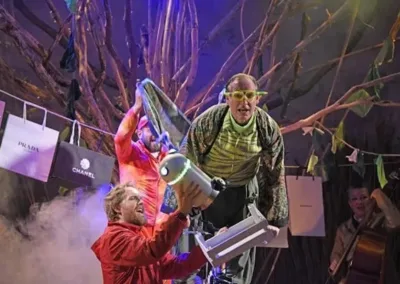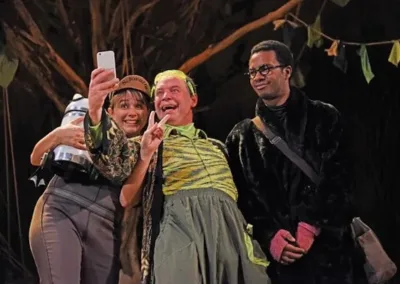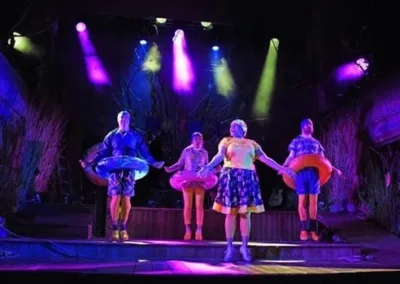The Wind in the Wi̵l̵l̵o̵w̵s̵ Wilton’s
4 stars
Show: The Wind in the Wi̵l̵l̵o̵w̵s̵ Wilton’s
Society: London (professional shows)
Venue: Wilton’s Music Hall. 1 Graces Alley, London E1 8JB
Credits: An adaptation, by Piers Torday, of Kenneth Grahame’s The Wind in the Willows. Directed by Elizabeth Freestone.
Image: Tom Chapman, Chris Nayak and Paula James. Photo: Courtesy of Wilton’s Music Hall
Just has he did with A Christmas Carol, Piers Torday has reimagined The Wind in the Willows to make it relevant and sharp for the 21st century. The inventive result packs a powerful anti-capitalist message and has a strong environmental message but also retains all the affirmation of friendship and collaboration which is what made Kenneth Grahame’s 1905 novel work in the first place. It’s also crisply fresh and very funny.
We’re in central London in a park, where the river is under threat from Weasel companies wanting to build everywhere and take control of the river. These people (sorry – animals) are ruthlessly self-interested. The Wild Wood is now the Animal Banking District and not a safe place for small animals who just want to live peacefully and simply.
Mole (Corey Montague Sholay) becomes a fastidious wimp, gradually learning to let go and enjoy life but very concerned about health and safety risk assessments. Toad – who has been in the theatre – played by Darrell Brockis, (also a whizz on the clarinet) is a deliciously flamboyant, cheek-kissing over-actor given to calling everyone “darling”. His obsessions are an electric exercise bike, an Alexa-type device, a very pretty drone and an e-scooter. The latter is illegal on river banks in the UK, as his Alexa reminds him.
The cast of seven, immaculately directed by Elizabeth Freestone are mostly actor-musicians who generate accompaniments for Chris Warner’s rather good songs as well as atmospheric sounds when, for example, there’s danger. And they’re a talented bunch. Rosie Wyatt is very convincing as Rat with a gore-blimey London voice and lots of rueful vulnerability beneath the feistiness. She also has a strong and beautiful singing voice and can multi-task. I can both play the violin and sing but I really envy and admire Wyatt’s ability to do them at the same time.
Melody Brown is a splendid Badger, curmugeonly and passionate about all the things she has campaigned for all her life but now weary. In an understated visual pun she is covered in badges to connote her causes. Tom Chapman is wonderfully slimy and nasty as the multi-millionaire Weasel and I liked Paula James in lots of ensemble roles but especially as the leader of the Duck Aerobics – a witty and rhythmic account of Grahame’s “Up Tails All”
Chris Nyak is a very versatile actor shifting from a West Midlands weasel to the hilarious poseur Otter who is then devastated by the loss of his baby daughter (nicely puppeted). He too races about seamlessly from one ensemble role to another.
Tom Piper’s set is impressive: lots of rushes and a big, twiggy upstage tree with branches which can be detached and waved by cast members. He also does simple but effective things with quasi-washing lines on which are pegged items to indicate setting. When we first meet Toad, for instance we chuckle at his expensive – Prada and so on – carrier bags on the line.
It’s a good idea to move the carol singers to the end of the show after the animals have worked together to regain Toad Hall and control of the river. It makes for an upbeat ending and I really liked the arranged of Joy Shall Be Yours in the Morning sung in harmony based mostly on bell-like descending arpeggios with hand bells to accompany. It is a good moment in pretty compelling show. I was also pleased the see no attempt to run a trial scene (it happens off stage with a bit of voice over) and Toad’s rather laboured escape from prison has gone. It’s all neatly constructed.
Torday’s underlying political point is that these animals were commonplace 117 years ago when The Wind in the Willows was written. Today they are almost all endangered or under threat. We have to stop concreting over their habitats in the interests of “progress” which, all too often is just a means of making rich people richer.
First published by Sardines: https://www.sardinesmagazine.co.uk/review/the-wind-in-the-wi%cc%b5l%cc%b5l%cc%b5o%cc%b5w%cc%b5s%cc%b5-wiltons/


